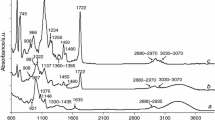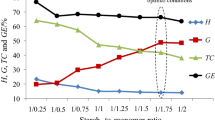Abstract
Purpose. The purpose of this study was to determine the glass transition temperatures of new graft copolymers using Modulated Temperature Differential Scanning Calorimetry (MTDSC), and to assess the differences between starch and cellulosic derivatives of methyl methacrylate and between two different drying methods used in their preparation.
Methods. Graft copolymers of methyl methacrylate were synthesized and dried by oven or freeze-drying. Surface area measurements and different thermal analysis techniques (Differential Scanning Calorimetry (DSC), Thermogravimetric analysis (TGA) and MTDSC) were used to characterize these copolymers.
Results. DSC was not sensitive enough to identify the Tgs of the copolymers, however they were clearly identifiable by MTDSC. Tg values obtained may depend on the method of preparation that also altered their physical characteristics e.g. specific surface area. Cellulose derivatives showed lower Tgs than starch derivatives. The results also depended on the drying method used, thus, freeze dried products had slightly lower Tgs than oven dried products.
Conclusions. MTDSC represents a useful thermal technique that allows the identification of glass transitions in these new copolymers with higher sensitivity and resolution than conventional DSC, separating the transition from overlapping phenomena such as decomposition or dehydration. The Tg of this new class of copolymers appeared to be dependent on polymer composition and drying method used.
Similar content being viewed by others
REFERENCES
N. J. Coleman and D. Q. M. Craig. Modulated temperature differential scanning calorimetry: a novel approach to pharmaceutical thermal analysis. Int. J. Pharm. 135:13-29 (1996).
K. Van der Voort Maarschalk, K. Zuurman, M. J. Van Steenbergen, W. E. Hennink, H. Vromans, G. K. Bolhuis, and C. F. Lerk. Effect of compaction temperature on consolidation of amorphous copolymers with different glass transition temperatures. Pharm. Res. 14:415-419 (1997).
K. Van der Voort Maarschalk, H. Vromans, G. K. Bolhuis, and C. F. Lerk. Influence of plasticizers on tableting properties of polymers. Drug Dev. Ind. Pharm. 24:261-268 (1998).
T. Keshikawa and H. Nakagami. Film formation with coating systems of aqueous suspensions and latex dispersions of ethylcellulose. Chem. Pharm. Bull. 42:656-662 (1994).
A. O. Okhamafe and P. York. Studies of interactions phenomena in aqueous-based film coatings containing soluble additives using thermal analysis techniques. J. Pharm. Sci. 77:438-443 (1988).
A. O. Okhamafe and P. York. Thermal characterization of drug/polymer and excipient/polymer interactions in some film coating formulation. J. Pharm. Pharmacol. 41:1-6 (1989).
J. Ford and P. Timmins. The use of thermal analysis in the development of solid dosage forms. In J. L. Ford and P. Timmins (eds.), Pharmaceutical Thermal Analysis, Techniques and Applications. Ellis Horwood, Chichester, UK, 1989, pp. 180-200.
J. Kerč and S. Srčič. Thermal analysis of glassy materials. Thermochim. Acta 248:81-95 (1995).
E. Selinger and C. J. Brine. Use of thermal analysis in the optimization of polymeric diffusion barriers in controlled release delivery systems. Thermochim. Acta. 134:275-282 (1988).
J. C. Seferis, I. M. Saliri, P. S. Gill, and M. Reading. Characterization of polymeric materials by modulated differential scanning calorimetry. Proceedings of the Greek Academy of Sciences, Nov., 1992, pp. 310-346.
C. A. Entwistle and R. C. Rowe. Plastification of cellulose ethers used in the film coating tablets. J. Pharm. Pharmacol. 31:269-272 (1979).
J. E. K. Schawe. A comparison of different evaluation methods in modulated temperature DSC. Thermochim. Acta 260:1-16 (1995).
I. Castellano, M. Gurruchaga, and I. Goñi. The influence of the drying method on the physical properties of some graft copolymers for drug delivery systems. Carbohyd. Polym. 34:83-89 (1997).
I. Castellano, I. Goñi, M. Gurruchaga, M. V. Velasco, A. Muñoz, and M. R. Jiménez-Castellanos. Contribution to the study of new graft copolymer matrices for drug delivery systems. Technological study. Int. J. Pharm. 146:71-79 (1997).
M. C. Ferrero, M. V. Velasco, A. Muñoz, M. R. Jiménez-Castellanos, I. Castellano, M. Gurruchaga, and I. Goñi. Drug release from a new family of graft copolymers of methyl methacrylate. Int. J. Pharm. 149:233-240 (1997).
M. C. Ferrero, A. Muñoz, M. V. Velasco, M. C. Monedero, and M. R. Jiménez-Castellanos. Comparative study on compaction mechanism of a new family of graft copolymers of methyl methacrylate. 16th Pharm. Techn. 1a:585-598 (1997).
M. V. Velasco, A. Muñoz, M. R. Jiménez-Castellanos, I. Castellano, I. Goñi, and M. Gurruchaga. In vitro evaluation of sustained-release matrix tablets prepared with new modified polymeric carbohydrates. Int. J. Pharm. 136:107-115 (1996).
S. Brunauer, P. H. Emmet, and E. Teller. Adsorption of gases in multimolecular layer. J. Am. Chem. Soc. 60:309-619 (1935).
B. Schenker and F. Stäger. Influence of the thermal conductivity on the Cp-determination by dynamic methods. Thermochim. Acta 304/305:219-228 (1997).
Author information
Authors and Affiliations
Rights and permissions
About this article
Cite this article
Ferrero, M.C., Velasco, M.V., Ford, J.L. et al. Determination of the Glass Transition Temperatures of Some New Methyl Methacrylate Copolymers Using Modulated Temperature Differential Scanning Calorimetry (MTDSC). Pharm Res 16, 1464–1469 (1999). https://doi.org/10.1023/A:1018971630036
Issue Date:
DOI: https://doi.org/10.1023/A:1018971630036




